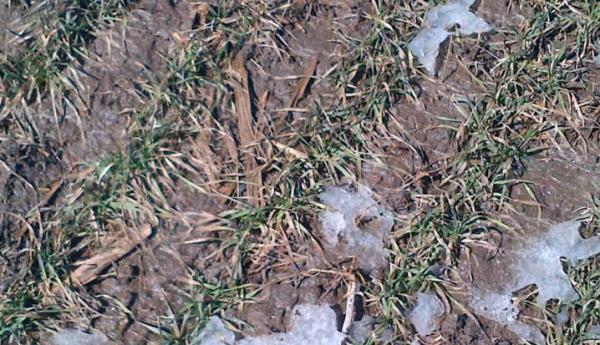To eat sweet corn love both children and adults. There is always a place for planting culture, it can be both the boundary of the fence and the middle of the plot. The main thing is that the bed is well lit by sunlight. Beginner gardeners before planting should be familiar with the features of agricultural engineering.Taking into account the region, it is necessary to decide whether or not to be afraid of frost in the spring and plant corn, certainly considering this factor.
Table of contents
When to plant corn in the spring in the suburbs, in Siberia and the Urals?
There is no need to hurry with the planting of seeds in open ground, they will not germinate in cold ground. In the southern part of Russia, landing at summer cottages begins in early May. For the middle band and the suburbs, the periods are more often shifted by 2-3 weeks. Cold-resistant varieties provide early seeding, however, to protect young shoots from freezing, it is recommended to use covering material at night. If weather conditions do not allow to start sowing, you should apply a seedling method of growing crops, which is typical for the Urals and Siberia.
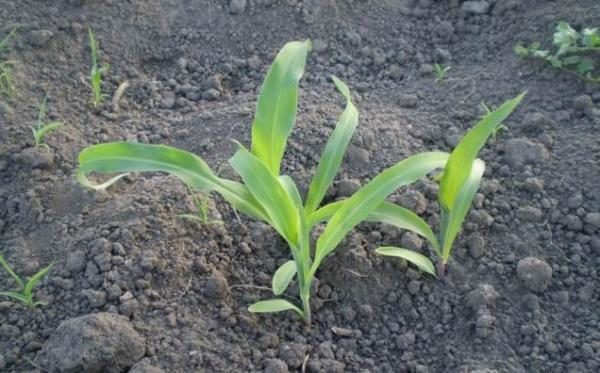
The weather conditions of Siberia allow to obtain the fruits of milky-wax ripeness, full ripening does not occur due to climatic features. Planting begin in late May or in early June.Experts do not recommend soaking the seeds, it suffices to do with the planting of good quality corn. And in order to sprout shoots faster, a black agrofibre cover is used. It attracts the sun's rays, creates a favorable environment for the development of sprouts.
Can the plant tolerate frost and how can it stand in the spring?
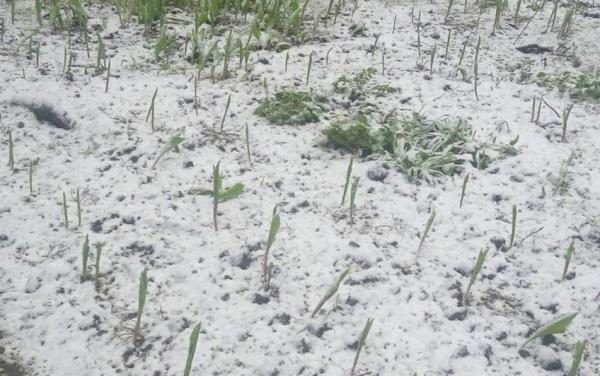
South America and the middle belt of the continent are considered to be the birthplace of maize, which indicates the thermophilic culture. Breeders had to attach a lot of effort to breed varieties and hybrids resistant to spring frosts. Seeds planted in open ground and seedlings withstand a minimum temperature of -1-2 ° C, and some hybrids up to -4 ° C. This is a great achievement, because the optimal temperature indicators in which the sprout develops are 12–18 ° C (the biological minimum is determined by the range of 8–10 ° C).
Depending on the temperature, the rate of germination of seedlings varies.The biological minimum ensures the germination of shoots in 18–20 days, whereas at + 20 ° sprouts appear above the soil surface in 5–8 days.
How to plant corn in open ground?
To grow the crop, what we want, you need to follow some rules on how to grow a crop. In time to sow the seeds, plant the seedlings in time, remember that corn, like any other inhabitant of a vegetable garden, is afraid of frost, endures it with difficulty (after all, Siberia is not Ukraine), and also in time to loosen the ground and feed the plant. It depends on how it will grow and how much fruit from the dacha will appear in carrying the house.
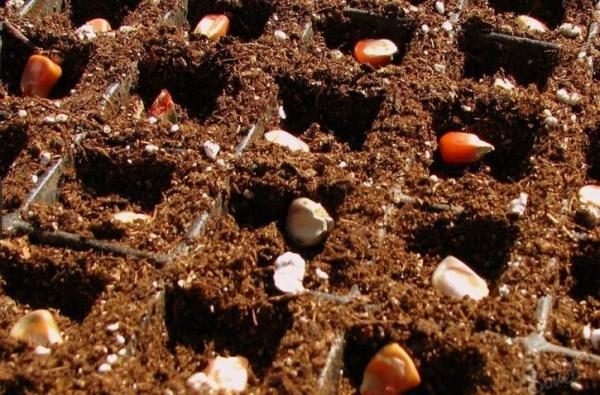
How to plant seeds and grow seedlings
In an open ground plant a crop can be seed and seedling method. For proper sowing of seeds for seedlings at home, cassettes (cells with a volume of 45 cm2) or peat pots (12 cm in diameter) are used. Containers are filled with fertile soil mixed in equal proportions with humus or compost. To reduce irrigation work, a hydrogel is added to the soil mixture.This component allows you to increase the moisture capacity of the substrate, reducing the number of procedures for moistening seedlings by 3-4 times.
In the spring, before sowing, seeds should be soaked, they spend 5-7 days in a damp cloth. After soaking, the swollen kernels are buried 3-4 cm in the prepared containers (3-4 pieces are put into the pots, 2 pieces are put into the cassette compartment).
Sprouting seeds is slow. At this stage it is important to maintain the desired temperature and good lighting.. With a lack of natural light, lamps with a fluorescent glow are installed, so they will grow faster. After the formation of 3-4 leaflets on the shoots, weak sprouts should be removed, leaving only sturdy-looking seedlings. A week before transferring seedlings to open ground, it is necessary to daily hardening to adapt to the natural habitat.

Landing in the spring in the land at their summer cottage, the scheme
For beds for corn choose a place without shading. The plant is drought-resistant, one of the main conditions of the growing season is a sufficient amount of sunlight. Not less important point is the observance of the landing pattern, because corn refers to the cross-pollinated species.For this reason, the bed is formed from several rows, otherwise there may be problems with pollination. Experienced gardeners use the following landing options:
- rows with a depth of 2 seeds each (the distance between the pits is 35 cm, the row spacing is 45-50 cm);
- square-nested method (the interval between plants is 45 cm on all sides or 9 shoots per 1 m2).
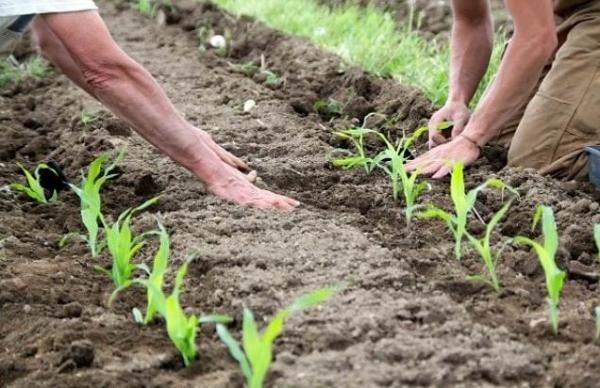
We plant corn in an open ground
Soil preparation in the country for cultivation
The plot of the bed must be carefully removed, removing all plant debris and weeds. It is better to do this in the fall, so that after digging, the larvae and pests are frozen out during the first frost. The soil will be ready for planting corn, if legumes or pumpkin crops, potatoes, cabbage were grown before it.
Fertilized manure is the most suitable fertilizer.. Also suitable are complex minerals that enrich the soil with micronutrients. The structure of the soil should be loose, so that the root system develops smoothly. The heavy soil is diluted with cut straw or sawdust.
The earth is first loosened, then the locations of the holes are marked.The depth of immersion of seed material is determined taking into account two factors: the degree of soil moisture and the condition of the seeds (dry or germinated). The swollen seeds are buried in a moist and warm soil to a depth of 3-4 cm, dry - 5-6 cm.
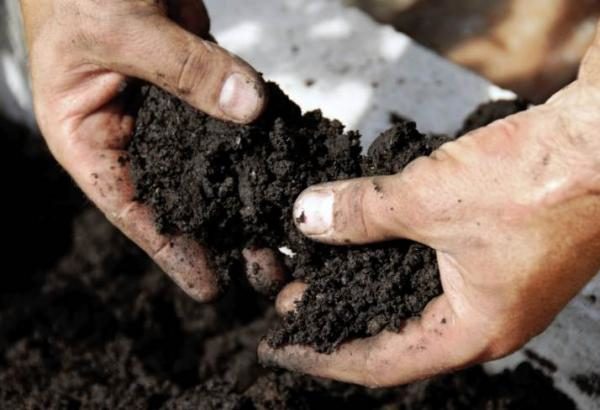
Care after planting so as not to be afraid of frost
Many people think corn is an unpretentious plant, requiring only weeding. However, it is not. To get a good harvest and cobs with excellent taste will have to follow simple rules of care.
Watering
Maize loves moisture, can absorb up to 4 liters per day. But this does not mean that the beds need to fill. Waterlogging slows down the development of the root system, changes the color of the leaves (a purple tide appears). These factors jeopardize crop yield, so irrigation should be based on the degree of soil moisture.The optimal rate of soil is 70-80%. When irrigation for each bush consumes 1-2 liters of water. If it is not possible to carry out regular watering, it is recommended to periodically loosen the ground. This procedure is popularly called dry irrigation. Loosening, in effect, prevents the soil from drying out. But the best way to maintain moisture in the beds is to use a point irrigation system.
The rates of water consumption at each stage of plant development are different. After transplanting, moderate watering will be required, after forming 7 leaves, the amount of liquid increases to 1.5 liters per bush. After the fibers on the cob begin to darken, irrigation is less frequent or the amount of water used is reduced.
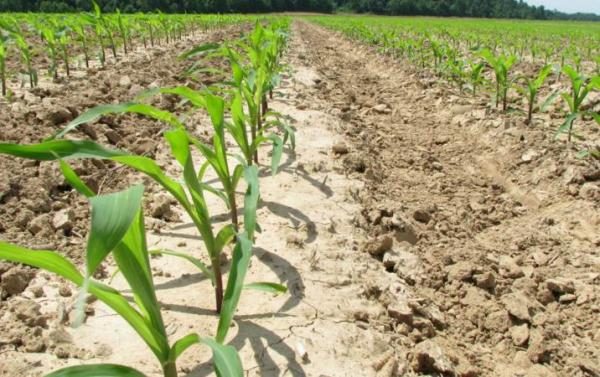
Weeding, loosening
Weeding prevents the thickening of the beds, which so attracts pests, creates favorable conditions for the development of diseases. Therefore, sprouted weed is periodically removed from the site.
This procedure is rational to combine with loosening the soil and hilling. This increases the permeability of the soil, allowing oxygen to nourish the deep layers.With this care, the root system develops better, strengthens the plant's immunity. When forming the stem part, corn becomes more stable, which allows it to withstand both gusting winds and heavy rainfall.
Top dressing
In addition to fertilizing the soil at the stage of preparation of the beds it is necessary to feed the plants. This is due to the increase in green mass throughout the growing season. Lure is introduced in several stages, and nutrients for each of them are strictly defined.
The first top dressing consists of slurry or a solution of bird droppings, which is applied after the formation of the 4th leaf on the shoot. After 2-3 weeks, a second feed is introduced, consisting of 20 g of ammonium nitrate, 20 g of potassium salt, 40 g of superphosphate per 1 m2. After the appearance of a 7-8 leaf, the plant needs to be fed with zinc, boron, copper and manganese.
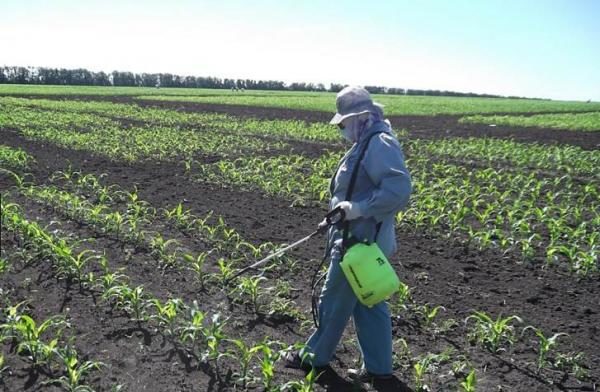
Corn farming is simple. One of the main issues requiring attention is the temperature regime,compliance with which creates favorable conditions for the growing season of the plant.
